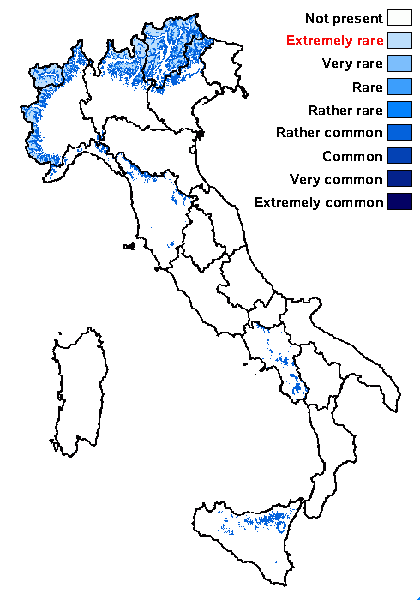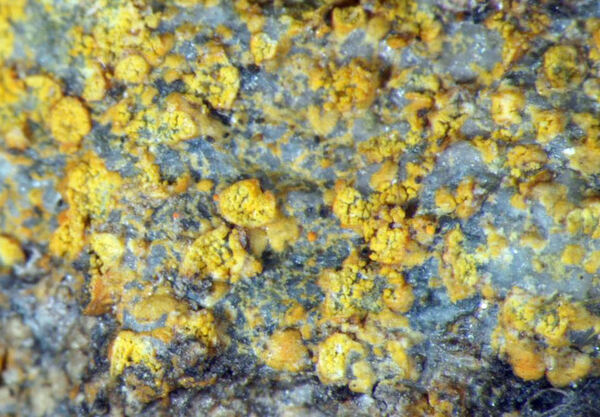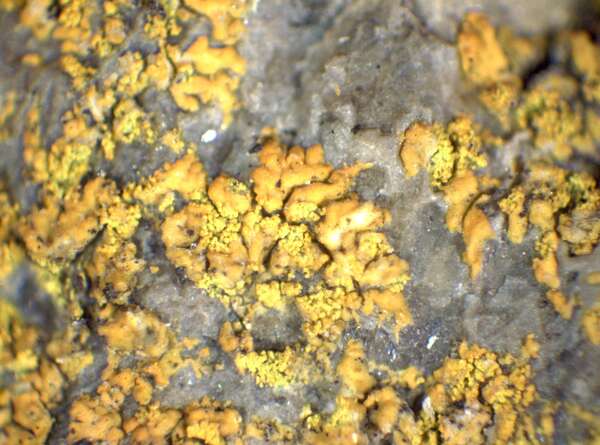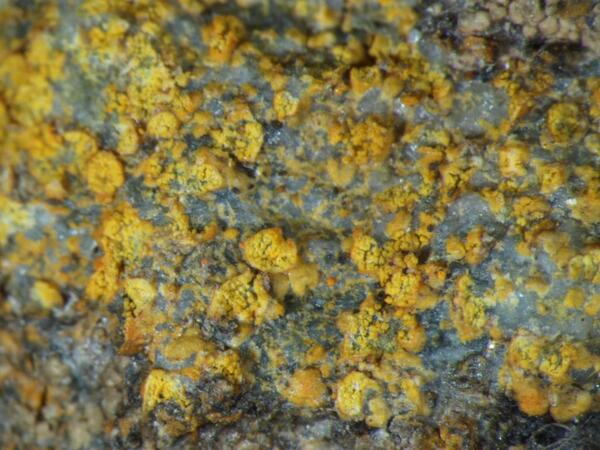Leproplaca obliterans (Nyl.) Arup, Frödén & Søchting
in Arup & al., Nord. J. Bot., 31: 72, 2013. Basionym: Placodium obliterans Nyl. - Flora, 57: 7, 1874.
Synonyms: Caloplaca obliterans (Nyl.) Blomb. & Forssell; Gasparrinia obliterans (Nyl.) Dalla Torre & Sarnth.; Lecanora obliterans (Nyl.) Nyl.; Physcia obliterans (Nyl.) Arnold; Placodium cirrochroum var. obliterans (Nyl.) A.L. Sm.
Distribution: N - Ven, TAA, Lomb, Piem (TSB 32645), VA (Piervittori & Isocrono 1999, Matteucci & Vanacore Falco 2015), Lig (TSB 33430). C - Tosc (Tretiach & al. 2008). S - Camp (Jatta 1909-1911), Si (Jatta 1909-1911).
Description: Thallus crustose, episubstratic, ochraceous yellow or pale to dark orange, continuous to areolate, forming irregular patches, often delimited by a thin, dendritic, pale orange prothallus. Areoles irregular, often minutely lobed, flat to convex, scattered to crowded, epruinose, up to 1(-1.5) mm long and to 0.3 mm wide, the central ones with concave and eroded, 0.1-0.5 mm wide, yellow to yellow-orange soralia. Apothecia rather rare, up to 0.5 mm across, with a flat to slightly convex, orange disc and a thin, concolorous or slightly paler thalline margin. Epithecium brownish orange, K+ purple-red; hymenium colourless, 50-65 μm high; paraphyses sparingly branched in upper part, the apical cells up to 5 μm thick; hypothecium colourless, 40-50 μm high. Asci 8-spored, clavate, functionally unitunicate, apically thickened with a broad internal beak, the inner part of apex and external cap I+ blue, Teloschistes-type. Ascospores 1-septate, polarilocular, hyaline, ellipsoid, 10-14 x 4-6 μm, the septum 2-4 μm thick (c. 1/3 of spore length). Photobiont chlorococcoid. Spot tests: thallus and apothecia K+ purple-red, C-, KC-, P-, UV+ orange. Chemistry: thallus, soralia and apothecia with parietin (major), fallacinal, emodin, teloschistin and parietinic acid (minor), corresponding with chemosyndrome A of Søchting (1997).Note: a cool-temperate to boreal-montane, circumpolar species found under overhangs of basic siliceous rocks, especially calcareous schists, mostly in upland areas; most frequent in the Alps, but also present in the Mediterranean mountains.
Growth form: Crustose
Substrata: rocks
Photobiont: green algae other than Trentepohlia
Reproductive strategy: mainly asexual, by soredia, or soredia-like structures (e.g. blastidia)
In underhangs rarely wetted by rain
Commonnes-rarity: (info)
Alpine belt: extremely rare
Subalpine belt: rare
Oromediterranean belt: absent
Montane belt: rather common
Submediterranean belt: absent
Padanian area: absent
Humid submediterranean belt: absent
Humid mediterranean belt: absent
Dry mediterranean belt: absent

Predictive model
Herbarium samples
Growth form: Crustose
Substrata: rocks
Photobiont: green algae other than Trentepohlia
Reproductive strategy: mainly asexual, by soredia, or soredia-like structures (e.g. blastidia)
In underhangs rarely wetted by rain
Commonnes-rarity: (info)
Alpine belt: extremely rare
Subalpine belt: rare
Oromediterranean belt: absent
Montane belt: rather common
Submediterranean belt: absent
Padanian area: absent
Humid submediterranean belt: absent
Humid mediterranean belt: absent
Dry mediterranean belt: absent

Predictive model
| Herbarium samples |
 Index Fungorum
Index Fungorum
 GBIF
GBIF







